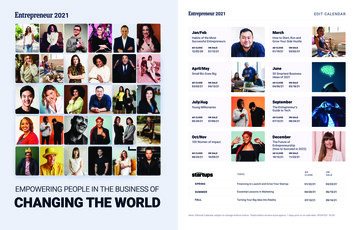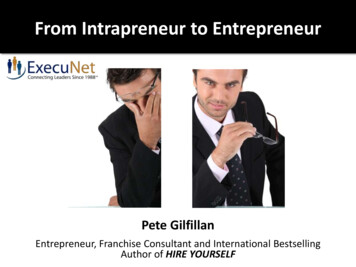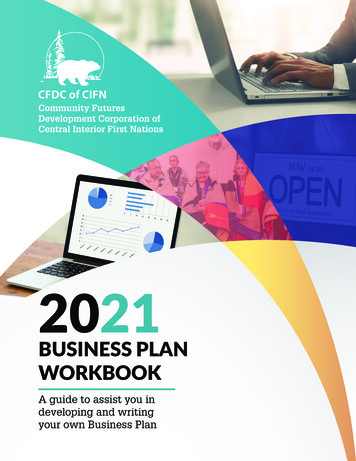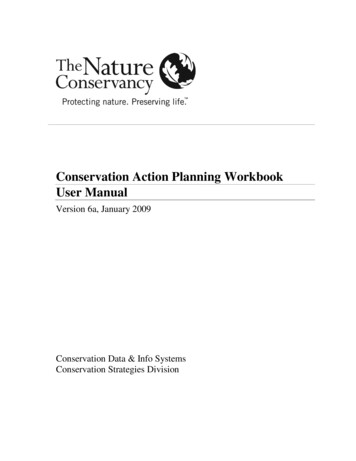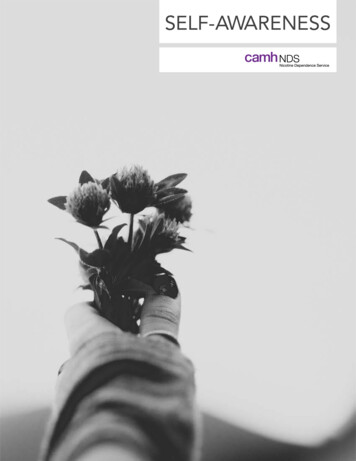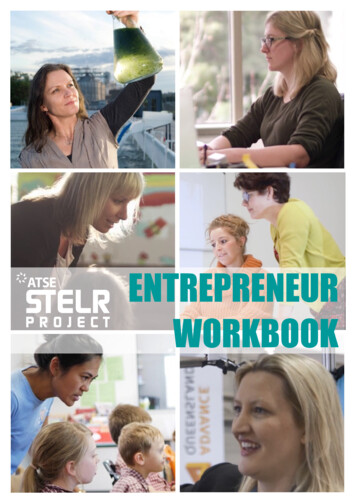
Transcription
ENTREPRENEURWORKBOOK
Entrepreneur workbookCONTENTSINTRODUCTION . 41. IDEAS ABOUT ENTREPRENEURSHIP . 51.1 My ideas .51.2 Who are entrepreneurs? .61.3 Entrepreneur mind map .72. WHAT IS AN ENTREPRENEUR? . 82.1 Defining Entrepreneurs .82.2 Entrepreneur word cloud .93. LOOKING AT ENTREPRENEURS . 103.1 How do Entrepreneurs make you feel? . 103.2 Entrepreneurial skills and behaviours . 123.3 Case study of an Entrepreneur . 144. PATENTS, INTELLECTUAL PROPERTY AND RIGHTS . 174.1Protecting your ideas. 175. DEVELOPING YOUR ENTREPRENEURIAL SKILLS . 205.15.25.35.46.ENTREPRENEUR CAREER PROFILES . 346.16.26.36.46.56.6STELR.ORG.AUcommunication skills and Work Experience . 20Pitch an idea for an App . 22assessing Risks . 26Innovate using an existing product . 30Catherine Ball . 35Emily de la Pena . 38Sarah Last . 41Vanessa Rauland . 44Liz Williams and Kate Lomas . 47Pia Winberg . 51ENTREPRENEUR WORKBOOK2
Entrepreneur workbookGLOSSARY 54APPENDIX ONE . 55Initals and acronyms. 55APPENDIX TWO . 56Useful websites . 56AUSTRALIAN CURRICULUM: WORK STUDIES . 57THANKS TO: . 58Download the Women in Stem Careers and Entrepreneurship poster at:STELR n-stem/ENTREPRENEUR WORKBOOK3
Entrepreneur workbookINTRODUCTIONThis resource encourages students to use STELR’s Women in STEM resources to come to a betterunderstanding of entrepreneurship through: Entrepreneurial skills and behavioursoCreating valuable goods/servicesoSelling the visionoCreative problem-solvingoOrganisational skillsoTaking risks and managing risksoTaking action and getting things doneoWorking collaborativelyoWorking independently Types of entrepreneurs Challenges and opportunities that can be addressed by entrepreneurs.Students can use the case studies provided to identify successful young entrepreneurs and look atthe challenges they addressed and the benefits to the individual, community or environmentalsustainability.Videos and written career profiles of the following entrepreneurs can be found on the STELRwebsite. Written profiles are also published in Section 6 of this booklet.Catherine BallA drone specialist and founder of five start-up companies.Emily de la PenaAn engineer who started coding clubs for kids and teachers.Sarah LastAn inventor with a passion for animal welfare and chicken farming.Liz Williams andScientists and inventors whose invention is helping the profoundly deaf.Kate LomasPia WinbergA marine ecologist with a start-up business in seaweed farming.STELR n-stem/ENTREPRENEUR WORKBOOK4
Entrepreneur workbook1. IDEAS ABOUT ENTREPRENEURSHIP1.1 MY IDEASBefore beginning these activities, write down what you think ‘entrepreneurship’ means to you.STELR.ORG.AUENTREPRENEUR WORKBOOK5
Entrepreneur workbook1.2 WHO ARE ENTREPRENEURS?Start a list of people that you think are entrepreneurs and add to it as you go through theseactivities.Name of entrepreneurSTELR.ORG.AUWhat they didENTREPRENEUR WORKBOOKWho benefits?6
Entrepreneur workbook1.3 ENTREPRENEUR MIND MAPWhat do you think it means to be an entrepreneur? What do you think are some of thecharacteristics of an entrepreneur? Make a mind map of your ideas.EntrepreneurSTELR.ORG.AUENTREPRENEUR WORKBOOK7
Entrepreneur workbook2. WHAT IS AN ENTREPRENEUR?2.1 DEFINING ENTREPRENEURSThere are many different definitions of an Entrepreneur.Entrepreneurship is the process of designing, launching, and running a new businesswhich is often initially a small business. The people who create thesebusinesses are called entrepreneurs.WikipediaOne who organises and manages any enterprise, esp oneinvolving considerable risk.Macquarie DictionaryA person who sets up a business or businesses, taking on financialrisks in the hope of profit.Oxford DictionarySomeone who undertakes a significant project or activity finding new or better ways of doi ngthings; they are opportunity-aware, take risks and utilise a range of behaviours, such as initiativeand innovation, that create value and contribute to their success.Australian Curriculum, ACARAQuestion 1. What do these definitions have in common?STELR.ORG.AUENTREPRENEUR WORKBOOK8
Entrepreneur workbook2.2 ENTREPRENEUR WORD CLOUDCollect some more definitions of ‘Entrepreneur’.Ask your friends, family and class mates what they think the definition is.Record (write down) the definitions.Pick out the important words in all the definitions (leave out the words such as ‘and’, ‘the’, ‘is’).Your task will be to create an Entrepreneur word cloud. You can use Wordle or Word It Out, by usingone of the programs below. Paste your word cloud in the space NTREPRENEUR WORKBOOK9
Entrepreneur workbook3. LOOKING AT ENTREPRENEURS3.1 HOW DO ENTREPRENEURS MAKE YOU FEEL?Entrepreneurship Videowww.stelr.org.au/women-in-stemWatch the Entrepreneurs video. Take a few moments to write down your thoughts belowQuestion 1. Overall, how did this video make you feel about entrepreneurs?Question 2. What did you think about the people in this video?STELR.ORG.AUENTREPRENEUR WORKBOOK10
Entrepreneur workbookQuestion 3. What behaviours did you see in this video?Question 4. What did you learn about entrepreneurs from this video?Question 5. Was there anything surprising in this video?Question 6. Did the video make you want to find out more? If so, what?STELR.ORG.AUENTREPRENEUR WORKBOOK11
Entrepreneur workbook3.2 ENTREPRENEURIAL SKILLS AND BEHAVIOURSThere are six videos in the Women In STEM series that are based on entrepreneurs: Catherine Ball Emily de la Pena Sarah Last Vanessa Rauland Kate Lomas and Liz Williams Pia WinbergChoose two of these to watch. Also read their written career profiles.Question 1. Make a list of as many characteristics and skills that they mention as ones beingimportant for entrepreneurs to have.If the characteristic or skill is mentioned more than once, note down the number of times it ismentioned.CharacteristicNumber of times mentionedAdd any new words and their meanings to the glossary on page 53 as you go along.Question 2. Rank the characteristics in order of how many times they are mentioned. Write downthe top five characteristics and skills. Compare your list with two other groups in the class.My top five characteristicsSTELR.ORG.AUOther group’s top fiveENTREPRENEUR WORKBOOKClass’ top five12
Entrepreneur workbookOptional activity: Create a word cloud for these characteristics to illustrate the most mentionedcharacteristics. Here is an example of a word cloud made using G.AUENTREPRENEUR WORKBOOK13
Entrepreneur workbook3.3 CASE STUDY OF AN ENTREPRENEURChose one of the entrepreneur videos to watch. Read the accompanying career profileResearch the entrepreneur further on the internet.Name of Entrepreneur:Question 1. What was the issue or problem that the entrepreneur identified?Question 2. What was the creative solution to the problem?STELR.ORG.AUENTREPRENEUR WORKBOOK14
Entrepreneur workbookQuestion 3. Who benefits from the solution to the problem? Individuals, communities, theenvironment?Question 4. Write a short paragraph about how they started their business.Question 5. Where are they located?Question 6. What characteristics does your chosen entrepreneur have?STELR.ORG.AUENTREPRENEUR WORKBOOK15
Entrepreneur workbookQuestion 7. Give examples of how the entrepreneur demonstrated characteristics such asConfidenceInitiativeWillingness to take a riskCreativity and innovationResilienceQuestion 8. What makes them different from other people in their industry?Question 9. Write down any ideas they mentioned about managing work-life balance.STELR.ORG.AUENTREPRENEUR WORKBOOK16
Entrepreneur workbook4. PATENTS, INTELLECTUAL PROPERTYAND RIGHTS4.1 PROTECTING YOUR IDEASWatch the Sara Last Video and read her career profile.https://youtu.be/SCqYbPPVq4MWhen some people watch this video, they are a bit confused because Sarah’s actual invention isnever shown.Question 1. Why do you think she does not show her invention?In small groups, brainstorm your ideas and write down some reasons why you think this is.In Australia, there is a government department called IP Australia that helps inventors andinnovators protect their ideas. Go to their website to answer the next questions :IP ing-ip/getting-started-ip/ip-explainedQuestion 2. What does ‘I P’ stand for?IP Australia manages four different types of protection for inventors and innovators: Patents Trade Marks Designs Plant Breeders RightsSTELR.ORG.AUENTREPRENEUR WORKBOOK17
Entrepreneur workbookQuestion 3. Briefly explain what each of these are:PatentsTrade Marks Registered DesignsPlant Breeders RightsSTELR.ORG.AUENTREPRENEUR WORKBOOK18
Entrepreneur workbookQuestion 4. IP Australia does not manage Copyright . Which Australian government departmentmanages copyright?Question 5. Briefly explain what copyright is.Look at the IP in everyday life page at the link below:IP AustraliaIP s-and-resources/ip-everyday-lifeQuestion 6. Explain how the following Australian innovations are protected?Qantas:Baby safety capsule:Polymer banknotes:STELR.ORG.AUENTREPRENEUR WORKBOOK19
Entrepreneur workbook5. DEVELOPING YOURENTREPRENEURIAL SKILLS5.1 COMMUNICATION SKILLS AND WORK EXPERIENCEMany entrepreneurs talk about the importance of networking with people and having goodcommunication skills. Just like sporting skills, you can practice your communication skills to get betterat them.Successful entrepreneurs are confident, self-motivated and are able to persuade other people to theirpoint of view.In this activity you can practice your communication skills by calling companies to find out if theyprovide work experience placement for secondary students.Calling up someone you don’t know is sometimes called cold-calling. This can be challenging for somepeople, but if you plan your call, then it makes the job easier.Step 1. Think about the type of industry with which you would like to do work experience.Step 2. Use the internet to find the names and telephone numbers of two or three nearby companiesin that industry.Step 3. Plan your callThink about what you are going to say. Then write down a script for the phone call.What to consider: How are you going to introduce yourself? Who are you going to ask to be put though to? What questions are you going to ask? If you get a positive response, what will you do next? If you get a negative response, what questions can you ask? (for example, if the company doesnot take work experience students could they recommend another company? Or if the person isnot available could they suggest another person or another time to call back?) How are you going to complete the call?STELR.ORG.AUENTREPRENEUR WORKBOOK20
Entrepreneur workbookStep 4. Set up a one-page document that you can use to record your phone conversation.Include on it the following: Name of company and phone number Date of call Name of person to whom you are speaking All the questions you want to ask with room to write in the answers A space at the bottom to write down any actions (such as when you agreed to call back) orthoughts that you had during the call (such other questions you might ask the next time you call).Step 5. Once you have called all the companies, write down your reflections.Include things like: What you thought before you started How the process made you feel What you learnt during the process What you would do differently the next time.STELR.ORG.AUENTREPRENEUR WORKBOOK21
Entrepreneur workbook5.2 PITCH AN IDEA FOR AN APPThese days there is an app for just about everything. Despite this, new apps are being createdeveryday.For example, you can use apps to: Order a food delivery Translate into another language Find out if the train is on time Online banking Listen to music Find directionsIn this activity, you will think up an idea for an app.You don’t have to make the app, but you have to think about ‘selling’ your idea to someone or agroup of people who is going to buy it or provide you with funds to develop it.Thinking of the ideaIdeas to help you think up an app: Work in small groups to think of an app that would help you at home or at school. Interview an older person (such as grandparents or parents) to find out something they havedifficulty with. Could an app help them?Question 1. What is the issue that your app is going to address?Question 2. How is it going to address the issue?STELR.ORG.AUENTREPRENEUR WORKBOOK22
Entrepreneur workbookQuestion 3. Who is it going to help? (What is the target market?)Name and logoBefore you sell your app it would be a good idea to give it a name and think about the logo or iconthat will be used to make a button for the screen when it is downloaded.A good name will help people to remember your product and will help you to ‘sell’ the product toyour market.The name should be easy to remember, as short as possible and easy to spell.Think of the names of products that you use to help you with your idea.Product ideas can: include the name of the inventor – Levi jeans, Hills Hoist be rhyming names – tutti frutti describe what it is – spray on skin describe what it does – Super Soaker , black-box flight recorder be made up of initials – DVD, SCUBAQuestion 4. Make a list of 5 possible names for your appTo help to choose a name, companies often undertake market research to find out which name isthe most popular.Market research can be carried out in different ways, such as by interviewing people or by writtenquestionnaires.STELR.ORG.AUENTREPRENEUR WORKBOOK23
Entrepreneur workbookQuestion 5. Carry out a quick survey to find out which of the names is most popular. Do this byasking at least 10 people to rank your ideas from 1 to 5 – with 1 being most popular and 5 beingleast popular. You could use a paper voting form or send an email with voting buttons.Write down how many people gave each score for each name.Add up the scores for each name. The one with the lowest score (the most number 1s) will be themost popular stion 6. Sketch an idea for a button icon for your app.STELR.ORG.AUENTREPRENEUR WORKBOOK24
Entrepreneur workbookPitching your ideaQuestion 7. Develop a presentation to sell your app.This could be a slide show, a short video or a poster.Keep it simple and to the point.In your presentation you might include things like: How you thought up the idea The problem that is being solved What research you have done to check that the app doesn’t already exist Why your idea is different from or better than other similar ideas Market research you did on the name Who the app is aimed at What other people think about your idea (you could include a testimony).Elevator pitchImagine that you are in an elevator and someone asks you what your idea is. You only have 1 minuteto explain it before they get out of the elevator. In that time you have to get your idea across to themand leave them thinking that they want to find out more.Question 8. Develop an elevator pitch to sell your app. Write it here.Practice saying it in a natural way (without notes).Present your pitch to the class.STELR.ORG.AUENTREPRENEUR WORKBOOK25
Entrepreneur workbook5.3 ASSESSING RISKSMany definitions of an entrepreneur use the term ‘risk taking’.Risk is sometimes defined as the potential of gaining or losing something of value. The valuablething could be your health, money or even social standing.Many entrepreneurs take financial risks by investing their money to develop and idea or productwhich may or may not become popular and make the money back. Taking a risk can be quitestressful. One way of easing the stress is to use a risk assessment template to help you thinkabout all the aspects of the risk before you take it.Question 1. Do you think taking a risk is a good or a bad thing? Write down some of yourthoughts.Work out the risks involved in making your breakfast.This risk assessment activity is based on assessing the risk to health rather than financial risk. Thefirst thing you need to do is think carefully about the hazards that might be present when youmake breakfast.A hazard is something or activity that could cause you injury. Once you have identified thehazards, then you need to decide on the likelihood of the hazard to occur and theconsequences if it does. This helps you to use the risk matrix to determine the risk level.For example:One of the hazards may be the possibility of burning your hand when boiling water for a cup oftea. What is the likelihood of this happening? How serious could it be?The consequence could be a bad burn needing medical treatment. The likelihood would depend onhow practiced you are at using the kettle and making tea.Using the matrix below, we can score:Consequence as moderate - level 3Likelihood as possible – level 3The grid then tells us that the risk level ismedium.STELR.ORG.AUENTREPRENEUR WORKBOOK26
Entrepreneur workbookHere is an example of a risk matrix.LikelihoodLikelihoodLevelDefinitionRare1May occur rarely (once in 100 years)Unlikely2Unlikely to occur (one every 10 years)Possible3Possible (once a year)Likely4Likely to occur (once a week)Almost certain5Prone to occur regularly (once a week)ConsequenceLevelDefinitionInsignificant1No injury / minimal financial lossMinor2Injury requiring first aid / medium financial lossModerate3Injury requiring medical attention / high financial lossMajor4Injury requiring hospital admission / very large financial lossSevere5Death / massive financial lossConsequenceRisk wLowMediumMediumThe next step is to think about how to reduce the risk. This could be either by reducing thelikelihood or the consequences or both.The risk level for burning yourself making tea could be reduced if you are properly trained in howto use the kettle. This does not reduce the consequences (because if you do drop boiling water onyour hand, the consequences would be the same), but it does reduce the likelihood.Another way of reducing the risk could be to be trained in first-aid for burns and apply an ice packto the burn straight away. This could reduce the consequences because the burn will not be aserious if the ice is applied straight away. Training in the proper use of appliances is also a way ofreducing risk. If you know how to use a kettle and you have practiced many times, risk can bereduced. Another way to reduce the consequences would be to wear protective gloves.STELR.ORG.AUENTREPRENEUR WORKBOOK27
Entrepreneur workbookQuestion 2. Use the Risk management template on the next page to complete the activity forpreparing your breakfast.Be careful to think about all of the risks not just boiling some water that was used for thisexample:Risks might include: Cutting yourself on a sharp knife Burning yourself on a hot drink Burning yourself on a stove or toaster Slipping on milk or water spilt on the floor A fat fire if you are frying eggs.Question 3. Were there any risks that were still not acceptable? What were they?Question 4. Discuss how any unacceptable risks could be managed. Write your ideas here:STELR.ORG.AUENTREPRENEUR WORKBOOK28
Entrepreneur workbookRisk management equenceDateRiskHow the risk couldNewNewRiskIs thislevelbe RENEUR WORKBOOK29
Entrepreneur workbook5.4 INNOVATE USING AN EXISTING PRODUCTEntrepreneurs can either invent a completely new product or they can improve on an already existingone. Improving an existing product is called innovation.Question 1. Go to the website below that lists 20 Australian inventions.Australian Geographic20 AustralianInventions thatchanged the -changed-theworld/Look at the following examples and decide if you think they are inven tions or innovations. Brieflyexplain your answer:Polymer (plastic) banknotes:Cochlear implant:Black box flight recorder:Spray-on skin:STELR.ORG.AUENTREPRENEUR WORKBOOK30
Entrepreneur workbookQuestion 2. Think about these products that were created through innovation. Fill in the answersbelow:What was it like before this innovation?What problem did the innovation solve?Who benefits from the innovation?Reusable tea bagsAre there any negative aspects to the innovation?What was it like before this innovation?What problem did the innovation solve?Who benefits from the innovation?Travel umbrellaAre there any negative aspects to the innovation?STELR.ORG.AUENTREPRENEUR WORKBOOK31
Entrepreneur workbookWhat was it like before this innovation?What problem did the innovation solve?Who benefits from the innovation?Bendy strawAre there any negative aspects to the innovation?What was it like before this innovation?What problem did the innovation solve?Who benefits from the innovation?Edible take-away spoonsAre there any negative aspects to the innovation?STELR.ORG.AUENTREPRENEUR WORKBOOK32
Entrepreneur workbookQuestion 3. Think about some existing products that have not been changed for a while or that couldbe changed for the better. To get inspiration, go to a supermarket, ask friends and family or talk withyour class-mates. Come up with an innovation that will make the product betterYour innovation could include: Combining two existing ideas (a pencil with an eraser on the end) Changing the shape or design of something (cooking utensils with big thick handles for peoplewith arthritis) Changing what it is made from (polymer banknotes).Sketch your product:What was it like before this innovation?What problem did the innovation solve?Who benefits from the innovation?Are there any negative aspects to the innovation?Name of product:STELR.ORG.AUENTREPRENEUR WORKBOOK33
Entrepreneur workbook6. ENTREPRENEUR CAREER PROFILESFollowing are the written career profiles that accompany the career videos that have beenproduced of Women in STEM and entrepreneurial careers. Ideally, students should access thisinformation and the videos at the same time.STELR n-stem/ENTREPRENEUR WORKBOOK34
Entrepreneur workbook6.1 CATHERINE BALLDr Catherine Ball trained as an environmental scientist and as a statistician. She is currently ChiefExecutive Officer (CEO) and founder of several companies mainly based on drones, coding androbotics.AT SCHOOLINSPIRATIONSCatherine was an enthusiastic learner, even atprimary school. She always loved sciencesubjects and languages.In secondary school, her favourite subject wasgeography and she had a dream that shewould travel to a new country every year.She was not keen on maths at school eventhough she eventually studied statistics atuniversity!In her final year of school in England, sheMy mum is a big hero for me. She alwayssaid to me “go out and do it and beyourself”. I could always rely on her if thingswent wrong.As a child, I fell in love with planet Earthfrom a very young age and DavidAttenborough was my ‘third parent’, I wasjust transfixed by wildlife.I’m also very grateful for my education andmy wonderful teachers.studied Biology, Chemistry, Physics andFrench. She was also in the debating team, theorchestra and the choir.I really threw myself into all the opportunities I hadat school and this has followed me throughout mycareer.When she was at school Catherine also didbaby-sitting jobs and worked in a pharmacyand a pizza shop.After she finished school, Catherine took a gapyear working in Zambia.UNIVERSITY AND FIRST JOBI originally thought I should study medicine, but then after my Gap Year in Zambia I decided to go withenvironmental science. We have enough medical staff really, and you can’t vaccinate against famine.Catherine’s first degree was in BSc with Honours (Environmental Protection). She then hadanother gap year working in Thailand, finding and recording new species of bananas. After that,she completed a PhD in Spatial Ecology and Predictive Statistics.My PhD gave me the wings to choose where I might work in the world, it was my passport to go where Iwanted to go or be what I wanted to be.STELR.ORG.AUENTREPRENEUR WORKBOOK35
Entrepreneur workbookCATHERINE’S ADVICE TO STUDENTSBECOMING AN ENTREPRENEURCatherine says that the key personal attributesWhen she came to Australia, Catherineand skills that have contributed to her successfirst worked as a consultant, advisingare:companies on environmental issues.Communication is key when you’re self-employed.Your network is your net worth. Relationships arevery important.Ability to identify new ways of doing things andcreating business opportunities with them. If youcan’t see new ways, then creating them is just asgood if not better.Catherine’s first project using droneswas looking at turtle rookeries (wherethey dig nest and lay their eggs) onislands off the coast of WesternAustralia which are difficult to get to.The project identified endangeredanimals that had not been seen inyears. She was inspired by theI never give up. Tenacity.She says that no person is an island, yournetworks and the strength and diversity of thosedirectly relate to how successful you’ll be.People don’t often talk about it but not havingpeople in your network can also be powerful. Don’tbe afraid to say no to things, sometimes peoplewant to connect with you for their benefit, not yours.STEM skills are going to be required by most jobsand in most businesses. Global challenges such asclimate change, population growth and aging willonly improve if we use STEM.Having a broad spectrum of experiences has beena huge factor in how I have been able to becomeindependent.If there is one piece of advice I could give youngpeople today, regardless of what career path theythink they might want is “travel, you have to travel,you have to get out there and see the world”.enormous potential of dronetechnology.Since then she has started up fiveSTEM-based businesses, that sheheads:Remote Research Ranges is companythat sends drone technology to remotecommunities to work with indigenousranger groups.SheFlies, co-founded with Dr KarenJoyce to encourage girls and womeninto STEM careers, to build confidenceby getting them to try their hand atsomething new - learning to fly drones.Co-Creator and Technical Convenor ofthe World of Drones Congress, whichaims to support the growing droneeconomy across the Asia Pacific region.Oneplanetwoman is a business shestarted to provide mentoring andsustainability guidance as well as startup advice to women in business.Gumption Trigger is a book thatCatherine put together. It highlights 14stories of Australian business womenand how they have found theirdetermination and resilience afterthings have gone wrong in their life.STELR.ORG.AUENTREPRENEUR WORKBOOK36
Entrepreneur workbookCATHERINE’S CURRENT JOBI am in charge of major strategic decisions across all my businesses. I am the technical convenor of theWorld of Drones Congress, so am in charge of the technical content.Catherine has built a successful career as an entrepreneur. She aims to grow her businesses and keeplearning and watching for new opportunities.She chose to work in this sector because she like to have fun and enjoy work life.I chose a place I could see a lot of opportunity. I used my personal brand to have conversations andraise issues around where there can be improvements, especially with regard to gender diversity inSTEM subjects.STEM AT WORKSTEM is a major factor behind my successes. My companies mainly involve the use of drones andcoding and robotics, as well as business and start-ups.Science skills really set you up for life. How to challenge things and learn about the world. If we don’tknow where we are, how can we know where we are World of Drones Congresshttps://www.worldofdrones.com.au/Remote Research Rangeshttp://www.remoteresearchranges.com/Gumption Triggerwww.gumptiontrigger.comENTREPRENEUR WORKBOOK37
Entrepreneur workbook6.2 EMILY DE LA PENAEmily de la
STELR.ORG.AU ENTREPRENEUR WORKBOOK 4 workbook INTRODUCTION This resource encourages students to use STELR's Women in STEM resources to come to a better . Write down any ideas they mentioned about managing work-life balance. Entrepreneur STELR.ORG.AU ENTREPRENEUR WORKBOOK 17 workbook 4. PATENTS, INTELLECTUAL PROPERTY AND RIGHTS 4.1 .
